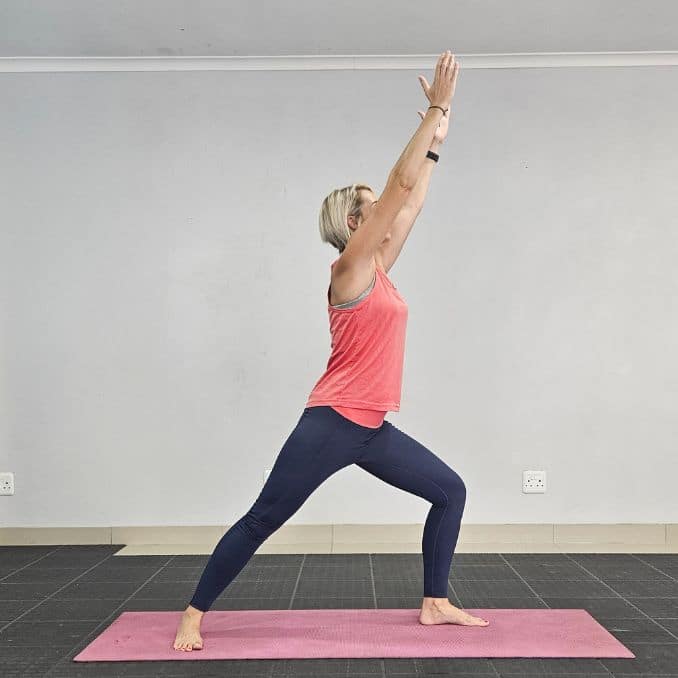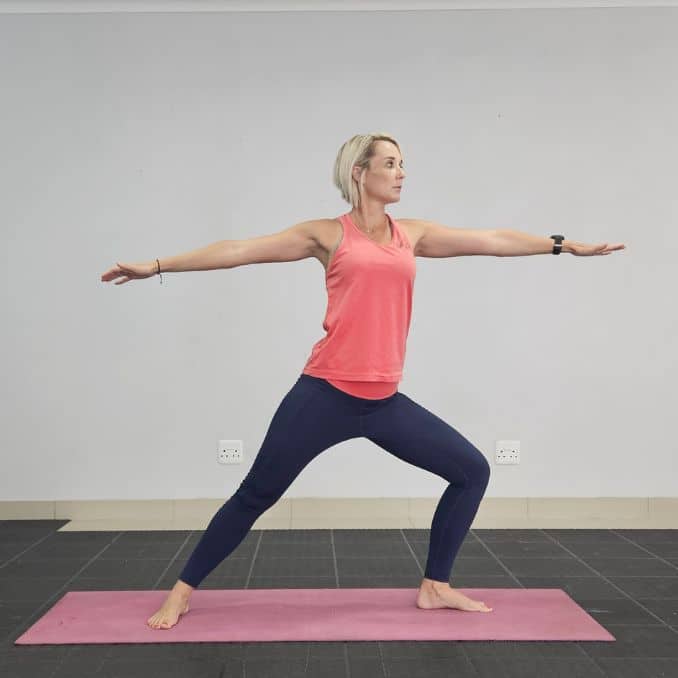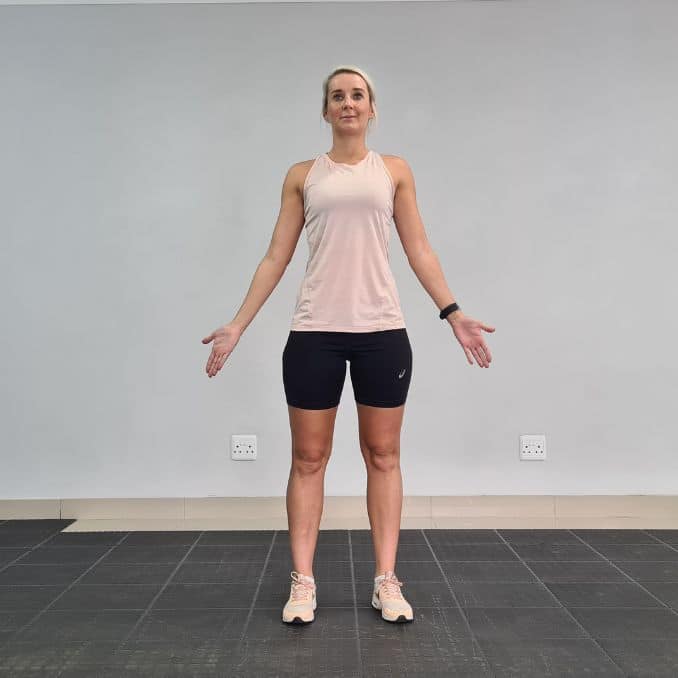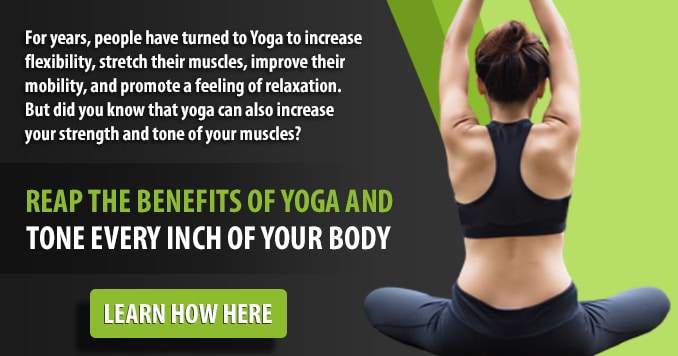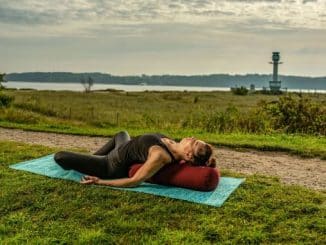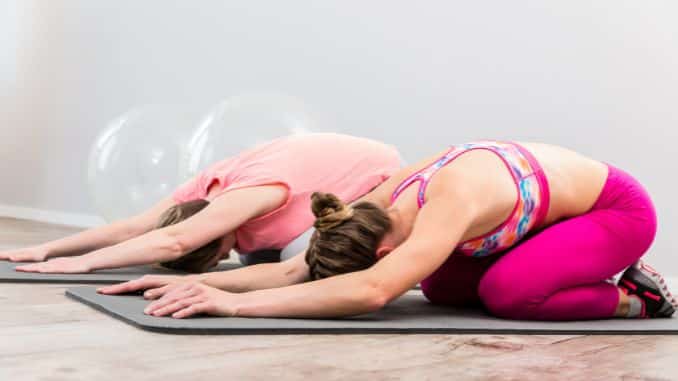
Are you looking to build strength and endurance while finding inner peace and relaxation? Look no further than yoga. Yoga is not just about striking graceful poses; it is a complete mind-body workout that can transform your physical and mental well-being. Yoga poses, also known as asanas, work by engaging and activating different muscle groups in your body. They focus on building strength and stability, improving flexibility, and increasing stamina. In this article, we will explore how yoga poses can help you enhance your strength and endurance, all while providing a sense of calm and balance.
Can You Build Strength and Endurance at the Same Time?
When it comes to fitness, many people believe that strength training and endurance training are two separate entities. However, the truth is that you can build both strength and endurance simultaneously, and yoga poses are a fantastic way to achieve this.
Strength training program typically involves lifting heavy weights or exercise performance with resistance to increase muscle mass. On the other hand, endurance exercise focuses on improving cardiovascular fitness and sustaining physical activity for an extended period. While these two types of training sessions usually differ in training intensity and duration, they are not mutually exclusive.
With its combination of static and dynamic poses, Yoga challenges your muscles while requiring you to maintain control and focus for an extended period. This combination of strength and endurance training makes Yoga an effective way to simultaneously build both aspects of fitness.
How to Build Strength and Endurance at the Same Time?
Building strength and endurance simultaneously requires a well-rounded approach to your workout routine. Here are some tips to help you achieve this goal:
- Incorporate high-intensity interval training (HIIT) into your yoga practice: By adding bursts of intense movements or challenging poses into your yoga routine, you can elevate your heart rate and increase the level of intensity of your exercise. This helps improve cardiovascular endurance and builds strength as you engage your muscles to perform these movements.
- Focus on compound movements: Instead of isolating specific muscle groups, choose yoga poses that simultaneously engage multiple muscle groups. This way, you’ll maximize your strength-building potential while improving overall endurance. Poses like the plank, chaturanga, and chair pose are excellent examples of compound movements that work multiple muscles simultaneously.
- Increase the duration of your poses: Aim to hold yoga poses for extended periods to build endurance. Gradually increasing your time in each pose will challenge your muscles and cardiovascular system, improving your endurance. Hold poses for 30 seconds and slowly work up to a minute or longer.
- Incorporate strength-focused yoga sequences: Design your yoga practice around sequences emphasizing strength-building poses. For example, you can create a sequence that includes the warrior series, boat pose, and dolphin pose. By consistently practicing these sequences, you’ll progressively develop strength and endurance.
Understanding Strength and Endurance in Yoga
Before exploring specific yoga poses to enhance strength and endurance, it’s vital to grasp these terms in a yogic context. In Yoga, strength denotes the capacity of muscles to exert force against resistance, whether holding poses for extended periods or transitioning between poses with control and stability. Conversely, endurance relates to sustaining physical activity without fatigue over an extended duration, evident in maintaining steady breathing and focus during challenging sequences.
Unlike traditional weight training, aerobic exercise, plyometric exercises, or cardio exercises, Yoga fosters strength and endurance comprehensively and balanced. It engages specific muscle groups and the entire body, including muscles, joints, and connective tissues. This holistic approach not only aids in injury prevention but also enhances overall functional fitness. Regular yoga practice cultivates a strong and resilient body well-equipped for various physical activities.
Benefits of Building Strength and Endurance with Yoga
Incorporating yoga poses into your fitness routine offers several significant benefits. Firstly, it helps improve muscle growth and definition by engaging muscles during poses and sequences, resulting in increased strength and endurance, ultimately leading to a leaner and sculpted physique. Secondly, Yoga enhances flexibility, which is crucial for maintaining a full range of joint motion and preventing injuries.
It is also a low-impact exercise, putting minimal strain on joints, making it a superb option for individuals with joint problems or those seeking gentler workouts. Beyond physical benefits, Yoga has a profound impact on mental well-being, reducing stress, anxiety, and depression through deep breathing, mindful movement, and meditation. This fosters a sense of calm and emotional resilience, enhancing overall performance in physical activities and everyday life.
Here are some Yoga poses that can help build strength and endurance. As you progress in your practice, you can explore more challenging variations of these poses or try different poses altogether. Remember to consistently tune into your body’s signals and adjust the postures accordingly to accommodate your current level of strength and flexibility.
Yoga Poses to Build Strength and Endurance
Now, let’s dive into some specific yoga poses that are particularly effective for building strength and endurance. It’s important to note that this is not an exhaustive list, and many other poses can help you achieve your fitness goals. However, these poses are a great starting point and cover many muscle groups.
Warm Up
1. Breaths with Arms
Begin in an upright standing position with your feet wider than shoulder-width apart, maintaining a good alignment with your head, shoulder, and hips. Engage your core. Bend your knees and hinge through your hips to move into an athletic position, crossing your arms in front of your body at chest height. Take a deep belly breath in through your nose as you lift your arms overhead in wide arcs. Exhale through your mouth as you reverse the movement to return to the starting position.
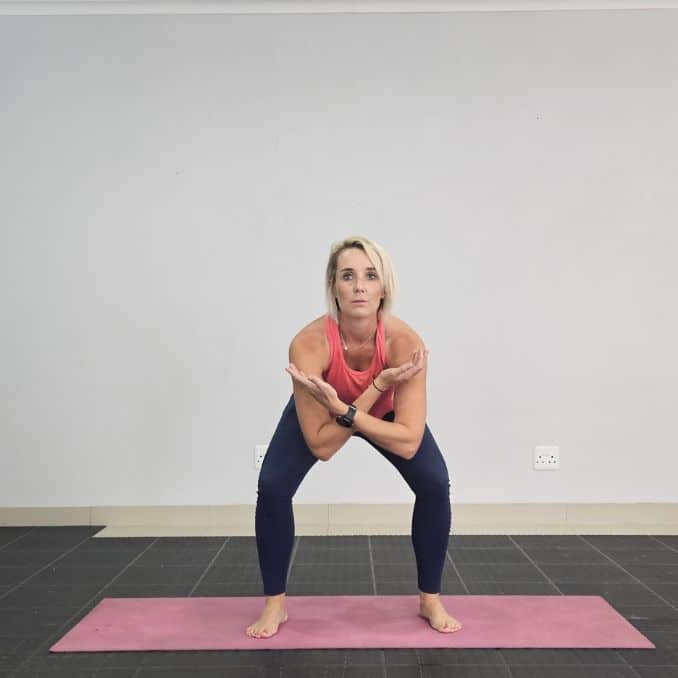 |
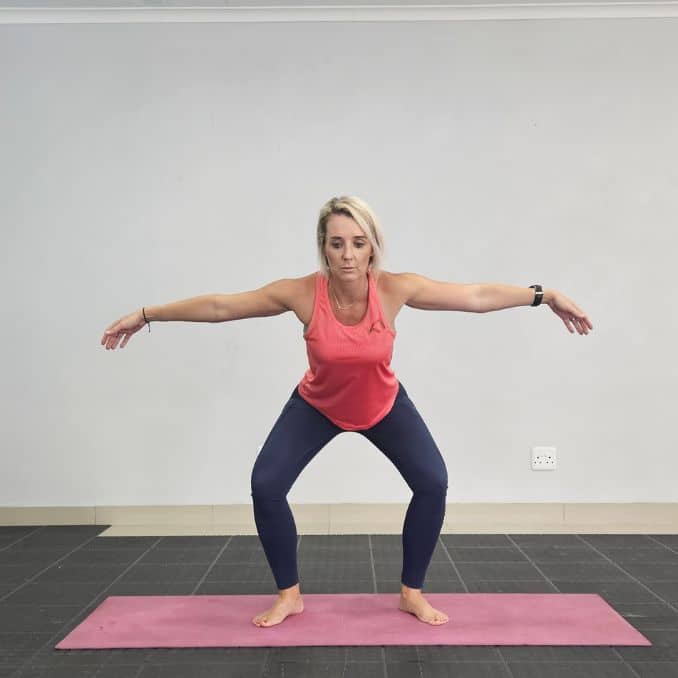 |
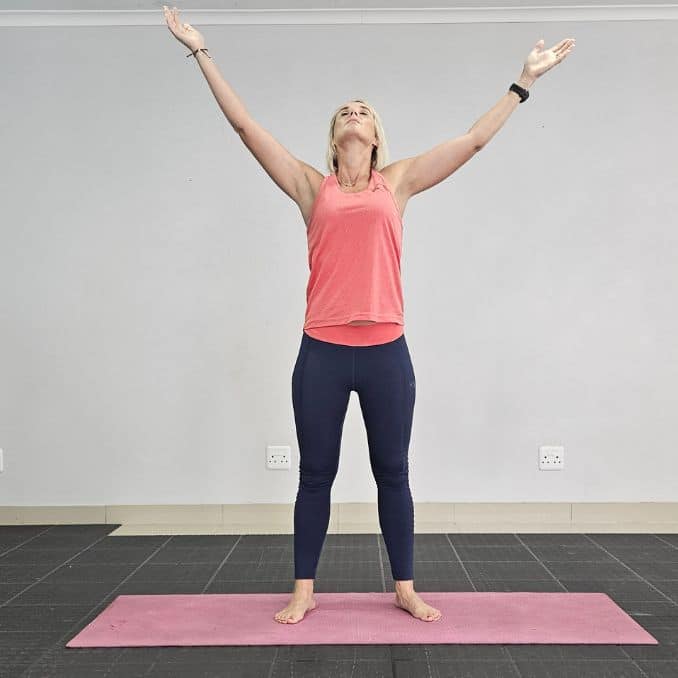 |
2. Overhead Reach with Side Bend
Begin in an upright standing position with your feet wider than shoulder-width apart, maintaining good alignment with your head, shoulders, and hips. Extend both arms overhead and interlace your fingers with your palms turned outward. Engage your core and bend your upper body to one side, holding the position for several deep belly breaths, in through your nose and out through your mouth. Relax and return to the starting position. Repeat the movement on the opposite side.
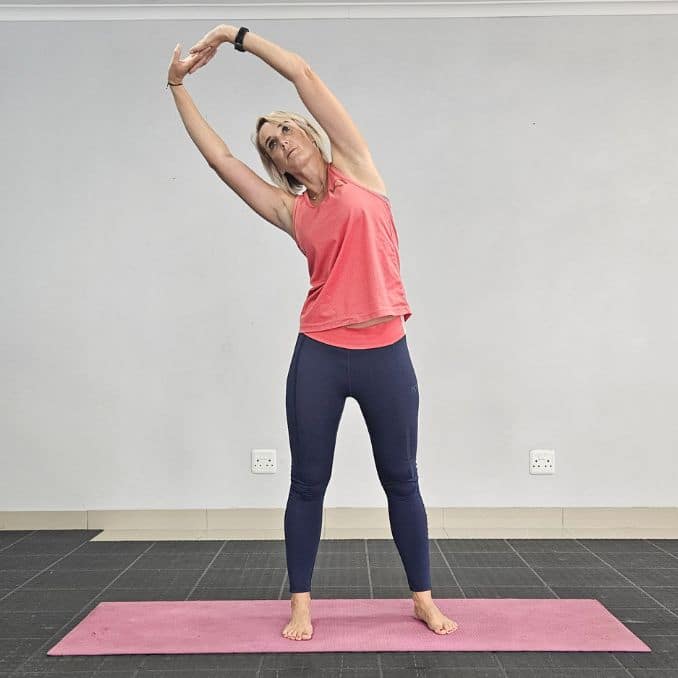 |
 |
3. Wide Spinal Twist
Begin in an upright standing position with your feet considerably wider than shoulder-width apart, maintaining a good alignment with your head, shoulder, and hips. Engage your core and rotate your upper body to one side, swinging your arms around your body as you lift your opposite heel up. Return to the starting position and repeat the movement on the opposite side, alternating directions.
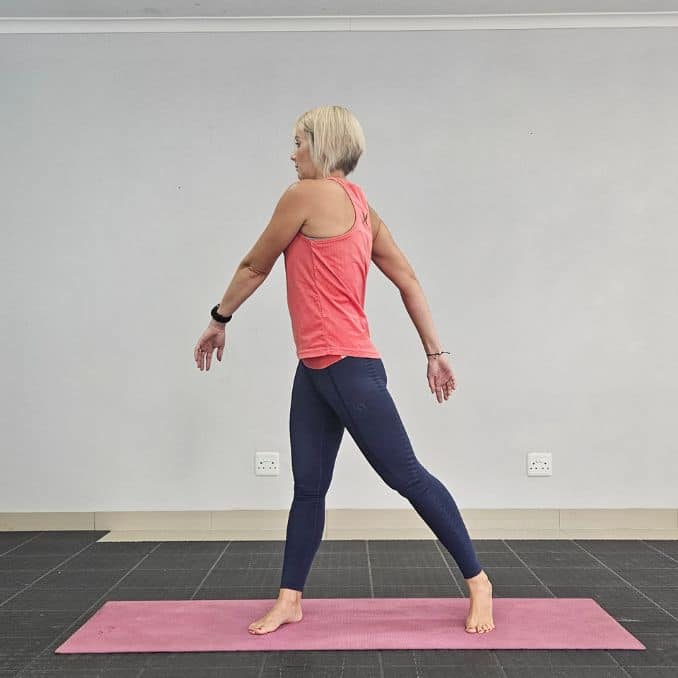 |
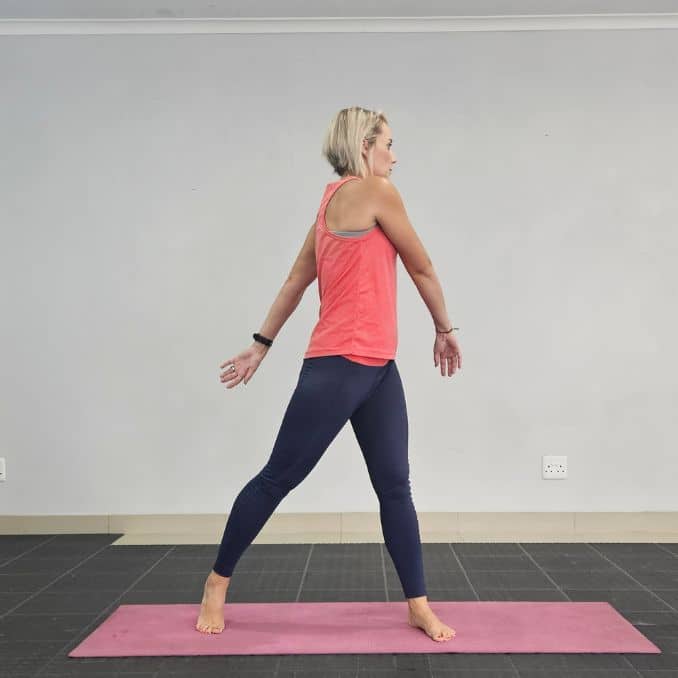 |
Routines
1. Warrior I
Begin in an upright standing position, maintaining good alignment with your head, shoulders, hips, and legs. Take a big step back with one leg, keeping your toes pointing straight ahead. Bend your front knee and straighten your back leg as you pivot your foot so that your toes are pointing out to the side, ideally at a 45-degree angle. Engage your core, shift your hips forward, and extend your arms overhead. Hold this position for four deep belly breaths. Return to the starting position and repeat the movement on the opposite side.
2. Warrior II
Begin in an upright standing position, maintaining good alignment with your head, shoulders, hips, and legs. Take a big step back with one leg, keeping your toes pointing straight ahead. Bend your front knee and straighten your back leg as you pivot your foot so that your toes are pointing out to the side, ideally at a 45-degree angle. Engage your core, shift your hips forward, and extend your arms out to the sides at shoulder height. Hold this position for four deep belly breaths. Return to the starting position and repeat the movement on the opposite side.
3. Balance Test
Begin an upright standing position with your feet hip-width apart, maintaining good alignment with your head, shoulders, hips, and legs. Place your arms at your sides with your palms facing outward. Engage your core. Close your eyes and bring awareness to your feet, grounding down through your feet by pressing through your heels. Hold the position for several deep belly breaths, in through your nose and out through your mouth. Relax and repeat the movement as needed.
4. Warrior III
Begin in an upright standing position, maintaining good alignment with your head, shoulders, hips, and legs. Place your hands at your sides. Engage your core and transfer all of your body weight onto one foot. Slightly bend your supporting knee and hinge your hips, bending forward until your upper body is parallel to the floor while extending your arms and opposite leg back. Make sure your hips are square to the floor and hold this position for four deep belly breaths, in through your nose and out through your mouth. Relax and return to the starting position. Repeat the movement on the opposite side.
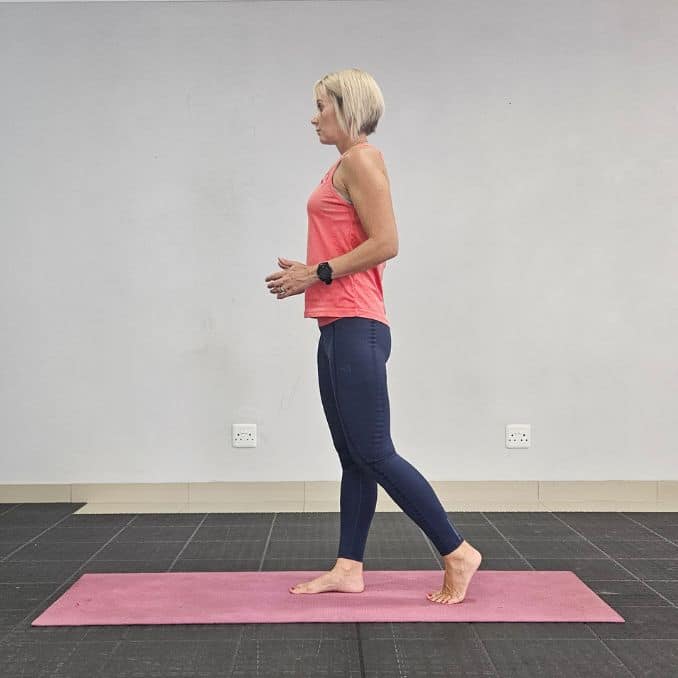 |
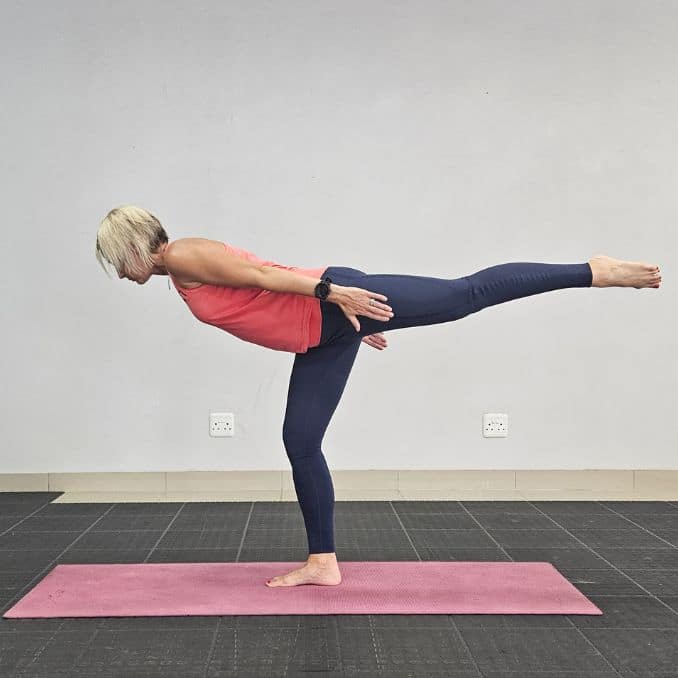 |
Note: You can point or flex your upper foot towards the floor for this exercise.
5. Breaths
Begin in an upright standing position with your feet hip-width apart, maintaining good alignment with your head, shoulders, hips, and legs. Engage your core. Take a deep belly breath in through your nose and lift your arms overhead in wide arcs. Exhale and lower your palms down toward the heart center, bending your elbows out at your sides. Return to the starting position and repeat the sequence of movements as needed.
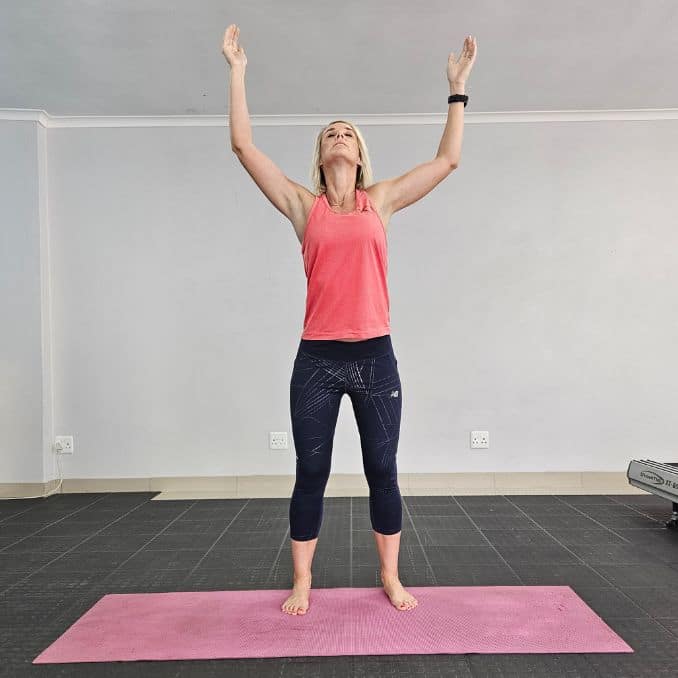 |
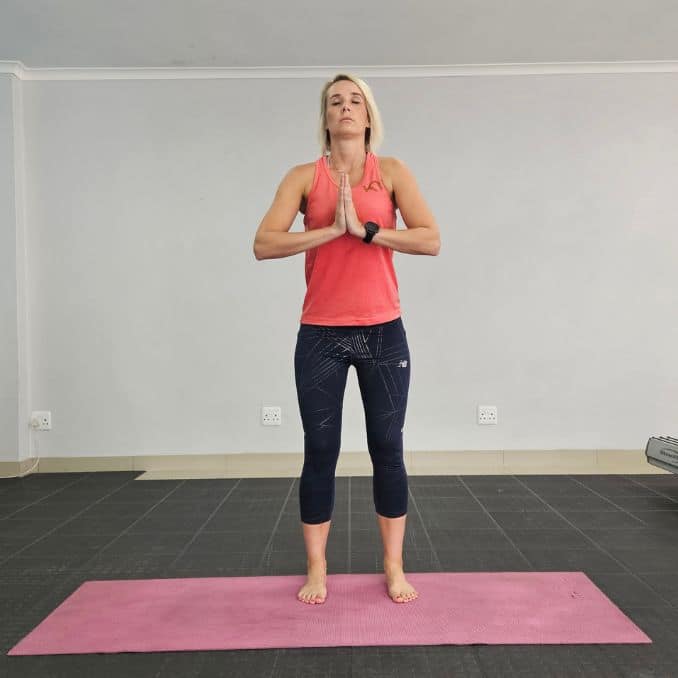 |
Be sure to tune in to your body‘s cues and modify the level of your practice as needed. Developing strength and endurance is gradual, so practice patience and find joy in the journey.
Why Build Muscle Endurance?
While building muscle strength is essential for overall fitness, incorporating muscle endurance training into your routine offers additional benefits. Muscle endurance pertains to the ability of your muscles to endure repeated contractions for an extended duration. Here are some reasons why building muscle endurance is crucial:
- Improved performance in daily activities: Good muscle endurance allows you to perform everyday tasks efficiently. Whether carrying groceries, climbing stairs, or participating in recreational activities, having muscles that can sustain prolonged activity without fatigue makes these tasks much more manageable.
- Enhanced athletic performance: Building muscle endurance can be significant for endurance athletes. Persistence allows you to maintain a high level of intensity for an extended period, giving you the edge in activities that require stamina, such as running, cycling, or swimming.
- Reduced risk of injury: Muscles with good endurance are less likely to fatigue quickly, which can help prevent injuries. When your muscles are tired, your form and technique often suffer, increasing the risk of strain or sprain. By improving muscle endurance, you can maintain proper form and technique longer, reducing the risk of injury.
- Increased calorie burn: Building muscle endurance can improve your overall calorie burn during exercise. As your muscles work harder and longer, they require more energy, increasing calorie burn. This can be beneficial if weight loss or weight maintenance is your goal.
By building muscle endurance alongside strength, you’ll create a well-rounded fitness routine that improves overall physical performance and contributes to your long-term health and well-being.
Conclusion and Final Thoughts on Using Yoga Poses to Build Strength and Endurance
Yoga is a beautiful practice with numerous physical and mental benefits. Incorporating yoga poses into your fitness routine can build strength and endurance while finding inner peace and relaxation. The diverse range of poses allows you to target different areas of your body and challenge yourself at your own pace. It’s important to remember that Yoga is a journey, and progress comes with consistent practice and patience.
Be kind to yourself, listen to your body, and celebrate small victories, embracing growth and self-discovery. If you’re ready to enhance your fitness journey and experience the transformative power of Yoga, start by including a few poses in your daily routine. Each pose offers something unique, whether it’s intense warrior poses, invigorating plank, downward dog, or gentle stretches of a restorative sequence.
As you deepen your practice and explore the world of yoga poses, you’ll build physical strength and endurance and foster a deeper connection with your body, mind, and spirit. Embrace the journey, and let Yoga’s transformative power guide you toward a stronger, more resilient, and balanced self.
Boosts your strength and endurance with yoga poses. Elevate your fitness game and find balance. Check out our 10 Yoga Poses to Tone Every Inch of Your Body.




